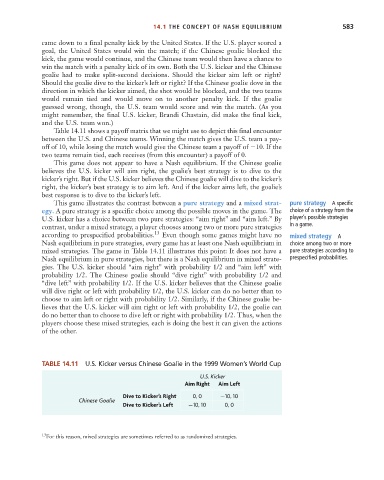Page 609 - Microeconomics, Fourth Edition
P. 609
c14gametheoryandstrategicbehavior.qxd 8/6/10 8:22 AM Page 583
14.1 THE CONCEPT OF NASH EQUILIBRIUM 583
came down to a final penalty kick by the United States. If the U.S. player scored a
goal, the United States would win the match; if the Chinese goalie blocked the
kick, the game would continue, and the Chinese team would then have a chance to
win the match with a penalty kick of its own. Both the U.S. kicker and the Chinese
goalie had to make split-second decisions. Should the kicker aim left or right?
Should the goalie dive to the kicker’s left or right? If the Chinese goalie dove in the
direction in which the kicker aimed, the shot would be blocked, and the two teams
would remain tied and would move on to another penalty kick. If the goalie
guessed wrong, though, the U.S. team would score and win the match. (As you
might remember, the final U.S. kicker, Brandi Chastain, did make the final kick,
and the U.S. team won.)
Table 14.11 shows a payoff matrix that we might use to depict this final encounter
between the U.S. and Chinese teams. Winning the match gives the U.S. team a pay-
off of 10, while losing the match would give the Chinese team a payoff of 10. If the
two teams remain tied, each receives (from this encounter) a payoff of 0.
This game does not appear to have a Nash equilibrium. If the Chinese goalie
believes the U.S. kicker will aim right, the goalie’s best strategy is to dive to the
kicker’s right. But if the U.S. kicker believes the Chinese goalie will dive to the kicker’s
right, the kicker’s best strategy is to aim left. And if the kicker aims left, the goalie’s
best response is to dive to the kicker’s left.
This game illustrates the contrast between a pure strategy and a mixed strat- pure strategy A specific
egy. A pure strategy is a specific choice among the possible moves in the game. The choice of a strategy from the
U.S. kicker has a choice between two pure strategies: “aim right” and “aim left.” By player’s possible strategies
contrast, under a mixed strategy, a player chooses among two or more pure strategies in a game.
according to prespecified probabilities. 13 Even though some games might have no mixed strategy A
Nash equilibrium in pure strategies, every game has at least one Nash equilibrium in choice among two or more
mixed strategies. The game in Table 14.11 illustrates this point: It does not have a pure strategies according to
Nash equilibrium in pure strategies, but there is a Nash equilibrium in mixed strate- prespecified probabilities.
gies. The U.S. kicker should “aim right” with probability 1/2 and “aim left” with
probability 1/2. The Chinese goalie should “dive right” with probability 1/2 and
“dive left” with probability 1/2. If the U.S. kicker believes that the Chinese goalie
will dive right or left with probability 1/2, the U.S. kicker can do no better than to
choose to aim left or right with probability 1/2. Similarly, if the Chinese goalie be-
lieves that the U.S. kicker will aim right or left with probability 1/2, the goalie can
do no better than to choose to dive left or right with probability 1/2. Thus, when the
players choose these mixed strategies, each is doing the best it can given the actions
of the other.
TABLE 14.11 U.S. Kicker versus Chinese Goalie in the 1999 Women’s World Cup
U.S. Kicker
Aim Right Aim Left
Dive to Kicker’s Right 0, 0 10, 10
Chinese Goalie
Dive to Kicker’s Left 10, 10 0, 0
13 For this reason, mixed strategies are sometimes referred to as randomized strategies.

